
GLENN LONEY'S SHOW NOTES
By Glenn Loney, September 14, 2000
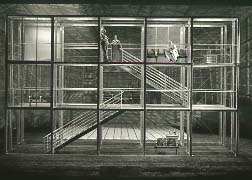
| |
| SILICON VALLEY HALL OF GIBICHUNGS--Post-Modernist set for Wagner's Götterdämmerung at Bayreuth. Photo: ©Bayreuth Festival 2000/Wilhelm Rauh. | |
[02] Bayreuth's New "Wonder" Ring
You can use your browser's "find" function to skip to articles on any of these topics instead of scrolling down. Click the "FIND" button or drop down the "EDIT" menu and choose "FIND."
How to contact Glenn Loney: Please email invitations and personal correspondences to Mr. Loney via Editor, New York Theatre Wire. Do not send faxes regarding such matters to The Everett Collection, which is only responsible for making Loney's INFOTOGRAPHY photo-images available for commercial and editorial uses.
How to purchase rights to photos by Glenn Loney: For editorial and commercial uses of the Glenn Loney INFOTOGRAPHY/ArtsArchive of international photo-images, contact THE EVERETT COLLECTION, 104 West 27th Street, NYC 10010. Phone: 212-255-8610/FAX: 212-255-8612.
THE WAGNERS—The Royal Family of Bayreuth:
Questions Regarding Precedence and Succession
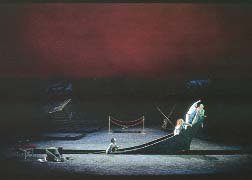
| |
| RHINE MAIDENS & SUNKEN SHIPS--Greedy dwarf Alberich teased by river-nixies in Bayreuth's new Ring. Photo: ©Bayreuth Festival 2000/Wilhelm Rauh. | |
In fact, as I was strolling with friends outside Wagner's celebrated Festspielhaus, a German gentleman in regulation tuxedo ran after us: "I heard you speaking English! What do you think of this new Ring? Isn't it dreadful? Siegfried is supposed to be a Hero, not a common rowdy!"
He was by no means alone among the many Perfect Wagnerites—and the stalwart members of the Gesellschaft der Freunde Bayreuths—in detesting the concept, direction, and design of the costly new production—which, like it or not, will be shown four more summers before it is retired!
Far more interesting—and certainly much more important—was the speculation about who will finally succeed 80-year-old Festival Director Wolfgang Wagner. Some impatient younger critics—including his niece, Nike Wagner—have been suggesting he should step down, in favor of newer ideas, more exciting productions, and younger leadership.
For almost a century, the Bayreuth Festspielhaus was the only private family-theatre opera-operation in Germany. Aside from John Christie's Glyndebourne Opera Theatre in England, it was the only one in the world. Certainly it was the only one mounting a major opera festival, devoted entirely to the works of its founder.
With the need to resolve the inheritance rights of Richard Wagner's four grandchildren—as well as to financially guarantee the survival of the annual festival—the Festspielhaus, Wagner's Villa Wahnfried, and the Master's surviving manuscripts and memorabilia were purchased by the State of Bavaria.
Although Wolfgang Wagner—who had revived the Festival after World War II, with his late brother Wieland—remained in control and continued his admirable work as a fund-raiser, business-manager, and artistic director, he was no longer the proprietor of the Festival and its historic theatre. The Wagner Family home became a museum.
The problem for some of Wolfgang Wagner's and Bayreuth's severest critics in recent years is their perception that the Festival has also become a museum.
Wagner's wise decision to invite such outstanding avant-garde talents as Patrice Chereau, Heiner Müller, Harry Kupfer, Dieter Dorn, and Jean-Pierre Ponnelle to direct at Bayreuth is not in dispute. Most of their often controversial productions at Bayreuth have now become part of Opera History.
It is Wolfgang Wagner's own recent stagings and designs which worry his critics. Is he too old now to continue directing and designing? Is he too old even to run the Festival?
This past summer, he was in very good form. He needed to be, for he has threatened to invoke the "lifetime" clause in his contract, if his wife, Gudrun Wagner, is not chosen by the Festival Council, which has to vote on the Succession.
When the Festival, its historic real-estate, and all the related Wagneriana passed to the Bavarian State, the principle was established that future direction of the Festival should, whenever feasible, pass on to a Wagner descendant.
The "Walsung" Race has by no means died out. But the leading Wagner contenders—including Frau Wagner—are by no means Young Turks anymore. They are certainly at least two decades younger than the feisty Incumbent. But not in the full bloom and enthusiasm of youth.
An important candidate for the post is Wolfgang Wagner's own daughter by his first marriage. She is Eva Wagner-Pasquier, who claims her Intendancy at the Royal Opera, Covent Garden, and at the Opéra Bastille in Paris as proof of her ability to run the Bayreuth Festival.
She seems a front-runner, though the voting has been delayed and delayed.
But her cousin, Nike Wagner, is also strongly favored by younger critics and commentators—who admire her writings about Wagner and opera. Her provocative proposals for a renewed Bayreuth—under her leadership—so impressed the New York Times that it reprinted them.
But some of her suggestions have been disparaged as impossible to implement. Or completely out of keeping with the historic character of the Festival. Among other controversial ideas, she has proposed fuller and longer use of the Festspielhaus.
This might not be feasible—at least if the excellence of the Bayreuth orchestra and chorus is to be maintained. The season has long been only five late-summer weeks, because the musicians and singers have been selected from the best opera-ensembles in Europe. They have to return to their own cities and theatres for the new fall season.
Many Wagner fans—myself included—have long wanted to see his early opera, Rienzi, given full Bayreuth treatment on that historic stage. But the Master did not wish that, so it has never been staged there.
Nike Wagner would do even more: she proposes staging his Die Féen and Das Liebesverbot, as well. She even suggests revival of some operas of his contemporaries. I'd certainly like to see Heinrich Märschner's Vampyr on the Festspielhaus stage.
Her critics insist that Nike Wagner—though a brilliant writer and theoretician—has never staged an opera. Or actually run an opera-house, as has Cousin Eva.
To run a major opera-house or festival successfully, one does not have to be a gifted stage-director. Bayreuth's very good fortune, in its post-war revival years, was to be led by the two Wagner brothers, who were both able directors, designers, and planners.
There's also another Wagner waiting in the wings. He is Wieland Lafferentz, son of Wagner's grand-daughter Verena, and currently chief of Salzburg's Mozarteum.
Wolfgang Wagner's banned son, Gottfried, has not put himself forward as a serious candidate. That would have given him a chance to settle some old scores, but it wouldn't have guaranteed the future of the Festival.
A constant and outraged critic of Bayreuth, its historic Festival, and, implicity, his own father, he charges that the Bayreuth Festival has never come to terms with the anti-semitism in his ancestor's operas, essays, and general Weltanschauung.
Nor, he insists, has the Festival properly acknowledged its complicity with Hitler and the Nazis, during the tenure of his grandmother, Winifred Wagner, as director.
In Nike Wagner's fascinating book about Wagner's operas, his theatre, and the Family—Wagner Theater—she points out the amazing patterns of repetition in family relationships and operation of the Festival.
Although she is obviously opposed to Uncle Wolfgang Wagner remaining in charge—and not only because of his age—she also makes it clear that she doesn't consider Aunt Gudrun and her daughter, Cousin Katharina, the right Wagners to succeed.
But, if the "Election Rests" on Frau Gudrun, this would be a repetition of an historic succession—which Nike clearly outlines in her excellent book.
When Wagner died, his devoted widow, Cosima Liszt Von Bülow Wagner, heroically carried on. Without her iron determination, the Festival would surely have died.
Her will to live, control, and promote Wagner was so strong that her son and successor, Siegfried Wagner, died only a month after she did, in 1930.
These dual tragedies impacted on the Festival. But Siegfried's wife, Winifred, proved to have an iron will of her own. She kept the Festival in operation almost until the end of World War II. But at a tremendous moral cost: depending upon the personal subsidy and friendship of Adolf Hitler.
This she never acknowledged as a Moral Failure on her part. She told me several times of her great admiration for Der Führer—which she maintained right to her death. The transcript of her De-Nazification proceedings must make interesting reading!
This is understandably one of Gottfried Wagner's sources of deep regret about Bayreuth and its history.
In Hans-Jürgen Syberberg's 1976 Bayreuth Centenary film—which features four hours of Gottfried's grandmother speaking directly to the camera about her fondness for Hitler and how he helped her save the Festival—her attitude is all too clear.
At the official Bayreuth Festival press-conference—which was held shortly after the film premiered in Bayreuth—an understandably angry Wolfgang Wagner apologized to the media: "You all know I cannot put a muzzle on my mother!"
When I paid her a call, at the Siegfried House, the day after this, she ingenuously explained that she had only agreed to talk about the History of the Festival on its 100th anniversary.
She insisted she wanted to help her grandson Gottfried, who didn't seem to have much going for him. He was working with Syberberg, so she agreed to answer questions about Bayreuth that he would put to her as the film ran through the sprockets.
In short order, the questions departed from distant historical context and began to focus on her relationship to Hitler—"Uncle Wolf" to her children—and his relationship to the Festival.
I had taken out my tape-recorder when I arrived, but she made me put it away at once. "Wolfgang doesn't want me to say anything more about this for the record. You understand?"
I certainly did. So I did not record what she then told me—which I'd already heard at length in Syberberg's film. It was a Wagnerian five hours long in Bayreuth, for he included an extra hour of edited out-takes!
No one can accuse Gudrun Wagner of anti-semitism. She has warmly welcomed both James Levine and Daniel Barenboim to the Green Hill to conduct major Wagner operas.
And both Frau Wagner and daughter Katharina know every aspect of Festival operation extremely well. After all, to run an opera-house successfully, you do not have to be a great conductor, singer, director, or designer.
But you do have to know who those talents are and lure them to work in your theatre. Then you have to raise the money to pay them—box-office receipts won't do it—and devise strategies to fill the seats.
The election of Gudrun Wagner would echo the historic pattern so carefully documented in Nike Wagner's Wagner Theater. Echo, not repeat, for she is not yet a Wagner Widow.
A CONTEMPORARY BAYREUTH RING—
Wonder & Flimm's 20th Century Saga of Greed
That is why the new Bayreuth Ring production of director Jürgen Flimm was only the Second Big Topic on the hill this past summer. Some humorists, however, wondered if it would become known as the Wonder Ring, or the Flimm [-flam] Ring. Curiously, though every Wagner fan refers to the 1976 Centennial Ring as the "Chereau Ring," the most recent Ring is clearly "Rosalie's Ring." No one thinks of calling it the "Kirschner Ring," after its director, Alfred Kirschner.
There is even a beautiful new book about "Rosalie's Ring," with stunning production photographs and Rosalie's set & costume sketches. Published by Hatje/Cantz, it's titled quite simply rosalie/Bilder zum Ring. In case you are wondering [that word again!], the lower case r is a stylistic choice. And this charming, innovative artist also chose not to continue calling herself her birth-name, Gudrun Müller.
Even though this avant-garde artist's unusual and colorful designs earned that Ring Cycle her name, that did not happen to Richard Peduzzi, who certainly gave the 1976 Ring its very special "Look." Possibly, many who say they admire the Chereau Ring either cannot remember who designed it, or never knew.
The "Wonder Ring" has a very fine sound to it—rather like the Magic Ring. The "Flimm Ring" has no real ring to its sound at all. For English-speakers, the director's name also sounds too much like phlegm, or flim-flam. Neither of these has pleasant connotations.
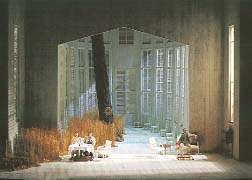
| |
| MARTHAT STEWART DECORATES HUNDING'S HUT--Stylish decor by designer Erich Wonder for Wagner's Die Walküre. Photo: ©Bayreuth Festival 2000/Wilhelm Rauh. | |
That puts him far out in front of Flimm, in terms of brand-recognition. The projected book on Flimm's concepts about the staging of the new Ring will appear only at the end of the year. Promised from Propyläen, it is already titled: Götterdämmerung/Der Neue Bayreuther Ring.
Conductor Giuseppe Sinopoli, Flimm, Wonder, and costume-designer Florence Von Gerkan will explain their guiding production concept[s]. The total absence of an essay by a lighting-designer—Manfred Voss is credited with all the lighting at Bayreuth—says something about the perceived importance of stage-lighting on the impact of a production on the Grüner Hügel.
This new volume also promises to be something of a justification for the philosophizing and psychologising of Flimm's two ingenious dramaturgs—who clearly are more responsible than Flimm for some of the visualized sub-texts they believe they have discovered.
These clever fellows are Udo Bermbach and Hermann Schreiber. Flimm admits they saved him a lot of reading about theories concerning the Cycle's possible meanings, academic and media critiques, and descriptions and reviews of past Ring productions.
The book will probably have to take the place of a color video of this impressive production. That is most unfortunate, for it is not only powerful musically, but also in purely theatrical and psychological aspects. But no one buys videos of operas anymore—at least that's the word from record-companies. Not 960 minutes worth of Wagner…
Flimm, Wonder, and Company had their work cut out for them. In German opera-theatres, the greatest challenge to designers and directors is mounting a new production of Wagner's Ring Cycle. This is so not only because it involves a sequence of four operas, totaling some 16 hours of performance.
The really major problem is how to eclipse what has been done before. This is especially true at the Bayreuth Festival, founded by Wagner in 1876, with a purpose-built theatre to provide a unique showcase for his works.
With the resumption of the annual festival after World War II, the brothers Wieland and Wolfgang Wagner—dedicated to Modernist innovations in design, staging, and technology—chose to call Bayreuth a "workshop." And the distinctive style of Wieland Wagner's idiosyncratic designs and stagings of his grandfather's operas became known as "New Bayreuth."
This had a profound influence on opera design and staging—and not only for Wagnerian Music-Drama—for several decades. After Wieland's untimely death, however, it became clear that startling and seminal new ideas would have to come from outside.
The "Chereau Ring" of 1976, largely designed by Richard Peduzzi, became a new standard of innovation and experiment. More recent Rings have been distinguished by the design insights of William Dudley, Hans Schavernoch, and Rosalie—the first woman ever to design the entire Ring. All of these important artists your roving reporter has interviewed on Bayreuth's Grüner Hügel.
When Wolfgang Wagner announced that the new Millennium Ring would be staged by Jürgen Flimm, with sets designed by Erich Wonder, speculation was rampant. How could Wonder top the Ring he had already designed for the Bavarian State Opera in Munich?
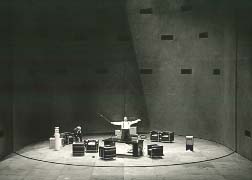
| |
| CEO WOTAN IN OVAL OFFICE--Wagnerian Gods are our contemporaries in new Bayreuth Ring. Photo: ©Bayreuth Festival 2000/Wilhelm Rauh. | |
Wotan's daughters—the Women-Warriors called Valkyries—zip into the space-ship on rocket-powered scooters. Quite an update from the winged horses Wagner had envisioned!
Obviously Wonder could not be more Futuristic than this. Nor did he want to try, for the new Ring. He explains that he was at that time inspired by SciFi and Steven Spielberg.
Working with Flimm—former director of Hamburg's Thalia Theatre, noted for the human quality of his productions—Wonder has concentrated on creating a series of inter-related scenes, in which basic set & prop elements reappear throughout the four operas. This not only emphasizes continuity, but it is the major indicator of a design style.
Flimm says the Ring should be seen, not as four operas, but as a play in four acts. He views the Ring as a very contemporary and cautionary saga: "…of a world ruined by corruption and unscrupulousness, a world of political careers, full of lust for power and murderous conflicts between generations." So he and Wonder have devised an almost Post-Modernist landscape in which to play out this tragedy of Gods and Mankind.
For Flimm, Wotan is a modern monster, an adept of Realpolitik, who breaks his own laws and kills his own children to increase his power. "In comparison," Flimm insists, "Kohl is a Garden-Dwarf."
As Flimm and his dramaturgs have noted: "A dramaturgy of locations determines the scenic landscape." In the first—and shortest—opera, Das Rheingold, Wonder and costume-designer Florence Von Gerkan seem to have begun visually where Patrice Chereau and Richard Peduzzi left off in 1976.
Their vision was a fantastic mixture of Myth and Industrial Revolution. In the new Bayreuth Ring, Wotan is still lusting for power, to keep what he has and seize even more. But his wardrobes—and those of his fellow gods—have been updated to the Edwardian era. At least in the prologue-opera of Rheingold. In the following three operas, when considerable time has passed, fashions of the Thirties and today mingle comfortably.
Flimm's emphasis in staging is not on Wagner's larger-than-life characterizations in his music and libretto, but rather on the all-too-human frailties of gods and men, as revealed in the actions and passions of the singer/actors. The result, both visually and emotionally for the audience, is of an abstracted modernist reality, populated by people they can recognize from TV and the daily headlines.
If Wagner's music were not played at all—thanks to Flimm's subtle direction, the ingenuity of the designers, and the almost unsuspected acting talents of the singers—this new Ring would still be an immensely powerful and moving theatre-experience.
Alan Titus, as Wotan, was a revelation: not only vocally, but also in the scheming authority and devious character he projected in his physical and emotional interpretation of the role.
And he was very well-partnered by Birgit Remmert as an intractable Fricka—with a fierce moral authority of her own. Oddly enough, she reminded me of the late Winifred Wagner, though this Fricka would certainly have told Hitler that his Thousand Year Reich was an even more disastrous idea than building Valhalla.
Last spring at the Met, Placido Domingo seemed ageing and fading as Prince Danilo. This summer at Bayreuth, years melted away as he became the desperate Siegmund, always on the run—but desperately in love.
This impressive change may well have been inspired by Flimm's personal direction—bringing out nuances in the character and encouraging Domingo to make them physically and emotionally real—instead of just singing about them.
Some German Wagnerites still disparage Domingo's sung German and attempts to sing Wagner roles at all. I could understand his German quite well, while some other German-speakers in the cast were not at all distinct.
But it was his Sieglinde who stole the spotlight. Waltraud Meier was contracted to sing the role in the Second Cycle, as she had the premiere. But she was already embroiled in a bitter dispute about rehearsal schedules with Wolfgang Wagner.
Wagner issued a special letter to the press, explaining the Festival's position. It appeared that Meier's fans could forget about seeing and hearing her at Bayreuth in 2001.
In the event, we didn't even get that privilege in the second Die Walküre. Only the day before the performance, she got a note from her doctor to prove she was sick. The next afternoon, Cheryl Studer was heart-breaking as Sieglinde.
Because all the performances thus far had obviously been very carefully rehearsed in acting terms for the human depths of the roles, some of us assumed she must have been previously rehearsed as well, as a potential cover for Meier. The performance was so assured, so moving, it could not have been a last-minute walk-on!
But it virtually was. She told colleagues she'd been on the beach at Marbella the afternoon before, when the call came from Bayreuth. She took to the air and arrived on the hill sometime after 2 am. The rest is opera-history. She was superb.
With far more taxing vocal, dramatic, and physical demands made of her, Gabriele Schnaut was also impressive as Brünnhilde. Also admirable in their special roles were Ricarda Merbeth as Freia and Mette Eising as Erda.
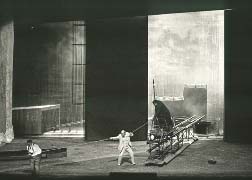
| |
| MINI-RAILROAD FOR GOLD TRANSPORT--Alberich taken prisoner by Wotan and Loge in Wagner's Das Rheingold. Photo: ©Bayreuth Festival 2000/Wilhelm Rauh. | |
Older Wagnerites were offended by Wolfgang Schmidt's lack of the Heroic as Siegfried. But his rough working-class appearance and rowdy behavior was just what one might expect of a contemporary lout, raised in filth, poverty, and ignorance, with no schooling or manners.
Don't any of these old-timers ever read the libretto? Siegfried has had a dwarf for a foster-father. And only a vague longing where a mother should have been.
Like Parsifal, he is a Tor, almost a simpleton. Though not a Holy Fool, alas. And he learns nothing from his tragic life-experience. He is the Instinctive Primitive Man: willful, selfish, quarrelsome, and boastful. He is, in fact, ultimately boring when dwelling on his heroic exploits in song.
But enough about the wonderful singing actors. What about the Erich Wonder wonders on stage?
For the initial scene—with the three Rhine-maidens frolicking at the bottom of the River Rhine—Wonder has devised three ancient ship-wrecks for their antics. They wear smart raincoats over their snug bathing-suits.
At the end of the Cycle, when the golden Ring is finally returned to them, a projection shows the Rhine-bed laden with sunken World War II battle-ships!
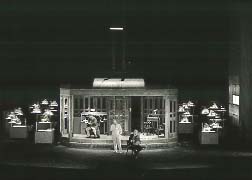
| |
| CARGO-CONTAINER AS OFFICE--Dwarf Alberich—with busy slaves sorting gold—entertains Wotan and Loge in new Bayreuth Ring. Photo: ©Bayreuth Festival 2000/Wilhelm Rauh. | |
Throughout the Cycle, Flimm and his designers make a strong visual point of the pairings of contrasting characters like Wotan and Alberich, Siegmund and Hunding, and Siegfried and Hagen.
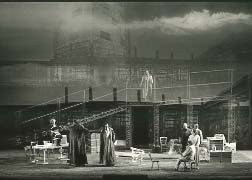
| |
| VALHALLA, NOT ANOTHER TRUMP TOWER!--Wagnrian Gods wait for new high-rise home to be finished in Erich Wonder's Bayreuth design. Photo: ©Bayreuth Festival 2000/Wilhelm Rauh. | |
Tables with architects' plans stand before a scrim showing the incomplete high-rise. Entrances made behind it, down scaffolding-steps, are visible, suggesting the insubstantiality of Wotan's plans and schemes.
The invention of the elevator made skyscrapers feasible, a fact not lost on Erich Wonder. Even in the depths of the Rhine, there is an elevator-cabin on a cog-rack reaching up into the flies. This is one of those design elements which recurs.
As in Wagner's libretto, there is a serious financial crisis for Wotan & Co. Cost-overruns mean Wotan cannot pay the builders, the giants Fasolt and Fafner.
Wotan has to let them take his wife Fricka's sister, Freia, as a hostage against final payment. Without her mythical golden apples, the gods promptly age, verging rapidly on decrepitude.
Loge, the trickster God of Fire, urges Wotan to go deep into the earth to take the Rheingold from his opposite, Alberich. Loge's costume is the epitome of an Edwardian sporting gent. Flames run down his arms, and smoke streams out of his briefcase, like a plume of exhaust. He cavorts like a Music Hall comedian.
Taking the elevator down to Nibelheim, Wotan and Loge find Alberich—in a three-piece suit—at his roll-top desk in an office set up in a cargo-container. On either side, dwarfs—in what look like radiation-safe uniforms—feverishly sort pieces of raw gold at individual work-tables.
When Alberich has been tricked and tied up by his devious visitors, he's forced to give up his horde of gold, plus the newly forged Ring and the helmet—here only a cloth—of invisibility, the Tarnhelm.
To deliver the treasure to the surface, Wonder has provided an opening of a mine-shaft, complete with a tracks and small flat-bed freight-wagons to transport the sacks of gold. This trackage even has a turntable, so Fafner can scoot his loot offstage, after murdering his brother giant.
The ruins of this rail-system turn up again in Siegfried, as Wotan returns to earth as the Wanderer to see how his grandson is developing.
To emphasize the parallels between Wotan and Alberich—whose son Hagen will later murder Siegfried and blast all of Wotan's hopes of power, even of survival—Flimm has added a young prep-school Hagen to the cast, something Wagner neglected to do. Of course, he is mute, but costumer Von Gerkan has outfitted him with regulation blue blazer and chinos.
Apparently, while Siegfried has been learning to forge swords in the cave of the evil dwarf, Mime, young Hagen has been coming back home to Alberich's Underworld Lair on weekends for help with his math.
A big disappointment for Wagnerite traditionalists in most modern Ring productions is the lack of a visible or recognizable Rainbow Bridge from earth to Valhalla. Rosalie suggested one with strings of brightly colored plastic pails suspended overhead.
Erich Wonder has actually indicated the bridge, but it is too far upstage and too dim to be easily seen. This could be corrected next summer, as changes are always made from year to year. But this visual vagueness—evident in Wonder's fuzzily painted backdrops for some other scenes—seems a conscious choice.
In the second opera, Die Walküre, Wotan's earthly twin children, Siegmund and Sieglinde, discover each other in Hunding's Hut. She is married to the warrior Hunding, and her previously unknown brother is on the run.
Wonder's interior is anything but a hut, but it does have an immense tree growing in it—as specified in the Nibelung Saga. The tree, now bent and crooked, turns up again in Mime's cave. In the final opera, it is only some shards of burnt roots.
For a simple hunter-gatherer, Hunding seems to live in a very elegant white conservatory, with tall, jalousied-windows. Martha Stewart could have been his design-consultant. The white furniture could have come from IKEA.
As could Wotan's Post-Modernist office-furniture in Valhalla.
Curiously, in addition to the large tree—with the magic sword Nothung stuck in it—clumps of river-reeds are also growing inside along the wall. This must emphasize the close connection with Nature of these primitive mythical characters.
When the incestuous twins declare their love, the back wall of the room flies up out of sight. Wagner specified "Spring" in the background, a visual metaphor for their new-found love. Wonder's painted background drape is dark and murky, more like Night on Bald Mountain.
Meanwhile, back in Wotan's Oval Office in Valhalla—complete with document-shredder, computer-monitor, mobile-phones, and water-cooler—an angry but business-like Fricka confronts Wotan with a dossier about the twins and his extra-marital infidelities.
These violations of his own divine laws—and of the sanctity of The Family—have got to stop. Or the gods are finished! She could be a female Trent Lott, harassing Bill Clinton! Or a Republican Fundamentalist, giving George W. Bush a piece of her mind.
Fricka is smartly but sensibly attired, and Wotan is the model of a top CEO. Wotan subsequently shreds her dossier.
Later, this space—defined by a curving wall upstage and a matching elliptical curve-track downstage—is converted to the Valkyries' rocky lair. The wall is pierced by six vertical apertures. although there are eight flying female warriors. So two have to double-up to sing from the heights.
Obviously, Wonder wouldn't give them old-fashioned Wagnerian winged horses to fly through the heavens. Or repeat his Munich rocket-scooters.
Instead, they rappel down from the flies, like Furies on bungee-cords. Although Wagner specified only eight of them—plus sister Brünnhilde—Flimm and his designers have outfitted a small platoon of apprentice Valkyries.
There are no ballets in the Ring, but Flimm has the women do close-order military drills to Wagner's "Ride of the Valkyries."
The dead heroes they bring to Valhalla look like a long, dazed line of the dead from Saving Private Ryan, dressed in World War II GI uniforms. Wonder may not completely have gotten over Spielberg yet.
The women take helmets and weapons from them, piling them in a heap upstage. Wotan later takes a helmet and breastplate from this pile to protect the sleeping Brünnhilde.
The Valkyries all seem to have perpetual Bad Hair Days, with immense tangles of wild hair. Their outfits appear a mixture of mountain-climber, space-cadet, and army surplus garb.
Unfortunately, Brünnhilde's outfit makes her look fat, inflated, almost like the Michelin Tire Man. When she sheds it, she seems in great shape!
Designer Von Gerkan is, in fact, a resourceful user of "found" costume elements. Siegfried's rough trousers are actually a Swedish motor-biker's pants she found in a New York flea-market.
Sporting a buzz-cut, Siegfried looks rather like a stocky Peter Sellars, the opera-director. This may be an inside joke, but his costume, appearance, and boorish behavior angered some spectators, who mistakenly believe Siegfried is an Ideal Hero. He is anything but.
The American Southwest may have had some influence on a drape—covering the curved wall upstage—that Wonder designed for the desperate flight of Siegmund and Sieglinde, pursued by Hunding. With low mountains in the distance, it has long rows of fence-posts with a central vanishing-point. A later, similar drape is a sunset montage of rows of posts stretching into infinity..
When Wotan puts Brünnhilde to sleep on a mountain-top, surrounded by the Magic Fire, Wonder suggests this by having two hinged sides of a giant curved golden screen close, resembling somewhat the ship-funnel form of Valhalla's exterior.
In fact, in the final moments of the Cycle, some critics were struck with the similarity of the ovoid tower and the forward smokestack of the Titanic—another construction headed for disaster.
At the beginning of Götterdämmerung, elements of Hunding's interior decoration are still in place, including the white chairs and the swamp reeds.
The Three Norns, in long gowns and white turbans, measure out the red thread of Human Life. But they also have very long-handled ladles—not for eating soup with the Devil, but for dipping water out of a rectangular spring—which later becomes a hearth.
When Siegfried ends his Rhine Journey at the Hall of the Gibichungs, he has clearly arrived in Silicon Valley. The hall is a great Post-Modernist glass-house of three floors, thronged with smartly dressed office-workers and Middle Management.
Hagen organizes a hunting party in Siegfried's honor. The company executives—in their tan, brown, and gray three-piece suits—are equipped with automatic pistols and folding stools, useful when Siegfried stops to sing of his heroic deeds.
After Hagen has killed Siegfried, secretaries come forward with funeral bouquets. When the sorrowing and suicidal Brünnhilde returns the Ring to the Rhine-Maidens, it's all over. The world that was is in ruins. Valhalla and the gods are no more.
Wagner suggested the return of the Ring—with the Rhine overflowing its banks—as a rebirth of the earth, a return to natural order. Flimm and his designers have quite a different vision—but also one of hope and promise.
Harry Kupfer ended his Bayreuth Ring with a little boy and girl with flashlights coming through the curtain onto the dark forestage, searching into the future.
The new Bayreuth Ring offers hope of a more mythical-historical kind. A blond boy in full medieval armor stands silently on stage. He is the youthful knight and redeemer Parsifal.
This visual footnote could spark a dangerous trend: Performing Wagner's Parsifal as a fifth sequence of the Ring Cycle, which would then make the saga over 21 hours long!
But there are other design & directorial elements which need more urgent rethinking before next summer's festival. Fafner as a Dragon, for example. This is a total visual and dramatic failure. But Bayreuth is a workshop, and every recent Ring has undergone design and staging changes from summer to summer.
At the Bayreuth Rathaus during the festival, Wonder showed some wildly colorful and abstracted paintings he calls "Siegfried's Memory." His canvas suggesting the dragon showed the chaotically tumbled coaches of an ICE super-train after a crash. That is an image he might want to develop.
Two paintings evoking the relationships between Wotan and Brünnhilde and Siegfried and Brünnhilde both show two flaming jet-planes colliding in midair. Obviously, this kind of imagery is too far out for the human-scale of Jürgen Flimm—who is the new Director of Theatre at the Salzburg Festival and President of the German Theatre Association.
On the basis of its interior decoration alone, this Ring could have come from IKEA, Now it's time to send it out to Cartier's for some polishing. Replace the rhinestones with real diamonds?
Gero Zimmermann, Bayreuth's long-time tech director, who is now departing, notes that the shops do not necessarily build everything that is designed. Some set-props and scenes for the Chereau Ring were passed over. For the Peter Hall/Bill Dudley Ring, some models and plans were not ready in time.
And, despite Erich Wonder's obvious ingenuity, over 15% of his designs were not executed, says Zimmermann. The reasons include costs, but also the problem of limited storage for all the sets and props of the operas in the summer repertory. [Loney]
Copyright © Glenn Loney 2000. No re-publication or broadcast use without proper credit of authorship. Suggested credit line: "Glenn Loney, New York Theatre Wire." Reproduction rights please contact: jslaff@nytheatre-wire.com.
| home |
reviews |
cue-to-cue |
welcome |
| museums |
recordings |
coupons |
publications |
classified |